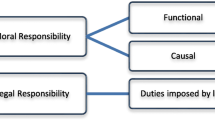Abstract
This article is based on the study of two companies that differ in their definition of thics, one with a narrower definition than the other. The one with the narrower definition invited skepticism about its commitment to the spirit of ethics but was better to claims made against their own standards and language. The implications of these findings for corporate ethics programs are discussed.
Similar content being viewed by others
References
Bies, R. J. (1987). The predicament of injustice: The management of moral outrage. In Cummings, L. L., & Staw, B. M. (Eds.),Research in Organizational Behavior (Vol 9). Greenwich, CT: JAI Press.
Cavanagh, G. F., Moberg, D. J., & Velasquez, M., (1981). The ethics of organizational politics.Academy of Management Review, 6, 363–374.
Cohen, M. D., & March, J. G. (1974).Leadership and Ambiguity: The American College President. New York: McGraw-Hill.
Eisenhardt, K. M. (1989). Building theories from case study research.Academy of Management Review, 14, 532–550.
Glaser, B. G., & Strauss, A. L. (1967).The Discovery of Grounded Theory: Strategies for Qualitative Research. Chicago: Aldine.
Goffman, E. (1952). On cooling out the mark: Some aspects of adaptation to failure.Psychiatry, 15, 451–463.
Greenberg, J. (1990). Looking fair versus being fair: Managing impressions of organizational justice. In Staw, B. S., & Cummings, L. L. (Eds.),Research in Organizational Behavior (Vol. 12, 111–157), Greenwich, CT: JAI Press.
Greenberg, J., & Cohen, R. L. (1982). Why justice? Normative and instrumental interpretations. In Greenberg, J., & Cohen, R. L. (Eds.), Equity and Justice in Social Behavior (437–469). New York: Academic Press.
March, J. G. (1987). Disussion. In Scully, M., & Meyerson, D. (Chairs).In Praise of Hypocrisy. Symposium presented at the annual meeting of the Academy of Management, New Orleans.
March, J. G. (1979). Foreword, In Krieger, S. (Ed.),Hip capitalism, Beverly Hills: Sage.
March, J. G. (1976). The technology of foolishness. In March, J. G., & Olsen, J. P. (Eds.),Ambiguity and Choice in Organizations (69–81). Bergen, Norway: Universitetsforlaget.
Meyerson, D., & Scully, M. (1990). Handling the heat: Negotiating the meaning of ethics during the implementation of corporate ethics programs in the defense industry. Working paper, University of Michigan.
Meyerson, D., & Scully, M. (1987), Janus in organizations: Coping with ambiguous role images. In Scully, M. & Meyerson, D. (Chairs),In Praise of Hypocrisy. Symposium presented at the annual meeting of the Academy of Management, New Orleans.
Meyerson, D., & Scully, M. (1988). A justification in time breeds nine: The case of corporate ethics programs in the defense industry. In Bies, R., & Sitkin, S. (Chairs),the Creation of False Peace: On the strategic Use of Explanations to Reconcile Irreconcilable Differences. Symposium presented at the annuaul meeting of the Academy of Management, New Orleans.
Miles, M. B., & Huberman, A. M. (1984).Qualitative Data Analysis. Berverly Hills, CA: Sage.
Reis, H. T. (1981). Self-presentation and distributive justice. In Tedeshi, J. T. (Ed.),Impression Management Theory and Social Psychological Theory (269–291), New York: Academic Press.
Schlenker, B. R. (1980).The Self Concept, Social Idenity, and Interpersonal Relations. Belmont, CA: Brooks/Cole.
Shklar, J. N. (1984).Ordinary Vices. Cambridge, MA: Belknap Press.
Tedeshi, J. T., & Reis, M. (1981). Verbal strategies and impression management. In Antaki, C. (Ed.),The Psychology of Ordinary Explanations of Social Behavior (271–309). London: Academic Press.
Tetlock, P., & Manstead, A. (1985). Impression management versus intrapsychic explanations in social psychology: A useful dichotomy?Psychological Review, 92, 59–77.
Weick, K. (1979).The Social Psychology of Organizing. New York: Random House.
Author information
Authors and Affiliations
Rights and permissions
About this article
Cite this article
Scully, M., Meyerson, D. The separation of law and justice: Managing impressions of corporate ethics programs. Employ Respons Rights J 6, 277–289 (1993). https://doi.org/10.1007/BF01385018
Issue Date:
DOI: https://doi.org/10.1007/BF01385018




